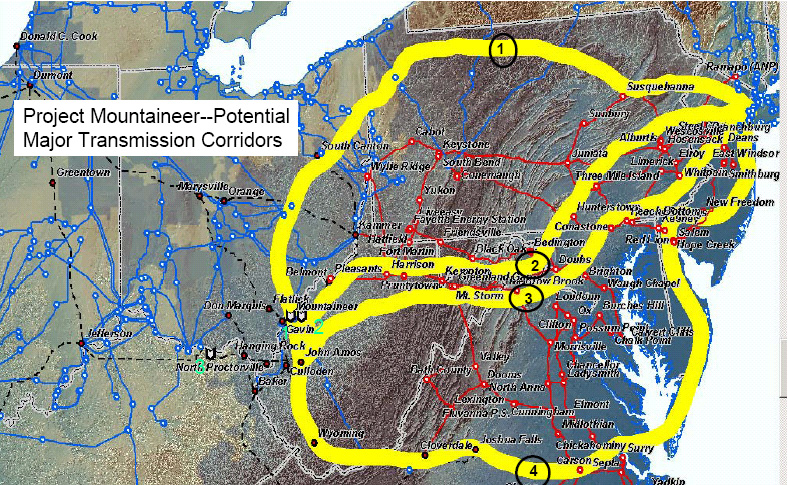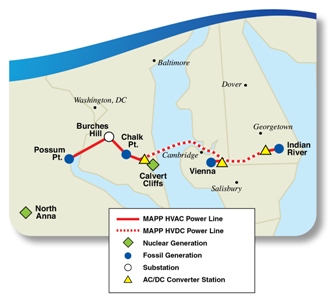MAPP is dead, dead, dead
August 8th, 2012
Just in today from PEPCO:
All,
I am writing to provide an update on PHI’s proposed Mid Atlantic Power Pathway (MAPP) project.
Today PJM issued the final results of its 2012 transmission analysis and due to factors such as lower load growth from the sluggish economy, the installation of new gas fired power plants, and the increase in demand response programs, no reliability violations were identified within the transmission planning window. As a result, the PJM Transmission Expansion Advisory Committee (TEAC) issued a recommendation that the MAPP project be canceled. On August 24, 2012, the PJM Board of Managers will meet to make a final decision on the TEAC’s recommendation.
I would like to express my sincere appreciation for your interest and participation in the MAPP project over the past few years.
Thank you,
Mark Okonowicz
MAPP – Environmental Coordinator
Pepco Holdings, Inc.
P – 302-283-6115
C – 302-463-5438
mark.okonowicz@pepcoholdings.com
This is after their bogus claims, in 2008, of skyrocketing peak demand (utterly unsupported by fact) from a June 25, 2008 MAPP Presentation found on the DNREC site — this “forecast” is so outrageous, and cancellation is SO HILARIOUS in light of Todd Goodman’s objections to my chalenging demand:
So let’s take a step back – what is MAPP?
No, this isn’t about the Mid-Continent Area Power Pool… it’s the Mid-Atlantic Power Pathway (MAPP), and it is DEAD!
The Mid-Atlantic Power Pathway, a transmission line that was part of “Project Mountaineer,” a coal transmission web that was hatched at a 2005 FERC meeting. MAPP was the NE part of line 4, below (Susquehanna-Roseland is the eastern part of line 1):
Here’s the transcript of that meeting, too scary, but it’s important to read this:
They tried and tried and tried, against evidence, to ram all these projects through. The did manage to get the first one through, the TrAIL (Trans-Allegheny Interstate Line) project, but PATH (Potomac-Appalachian Transmission Highline) is dead, Susquehanna-Roseland is permitted but not yet built…
Slowly but surely, PJM is admitting that transmission is not “needed” by any measure. With MAPP, first they planned it as above, in the first map, and then they eliminated the part in Delaware from Indian River to Salem/Hope Creek nuclear plants:
Despite this, Delaware’s DNREC issued permits for part of this project in Sussex County, Delaware! Whatever for? Why would they do this? Aren’t they paying attention to things electrical? DNREC should know this is not needed
Here is today’s good news — PJM’s latest review, just released, showing NO THERMAL VIOLATIONS — DUH:
Here are two slides that say it all, the first focused on PATH but including MAPP, and the second, the “MAPP Project Analysis” results:
And the bottom line? Another DUH, GOODBYE PATH AND GOODBYE MAPP:
Once again, we’re proven right. How long have we been fighting all these transmission projects, how much time, effort and money showing it’s not needed, even when using INDUSTRY studies, documentation, forecasts. All their claims of need are fabricated, reverse-engineering to get the result they want, billions of dollars of PRIVATE INTEREST, not PUBLIC interest, projects, built on the backs of landowners, with a FERC guaranteed 12+% rate of return for the owners/builders/developers.
The down side is the ratepayers are probably going to be hit with all these development costs because so many jurisdictions allow recovery for “CWP,” construction work in progress. So we get screwed, but not as badly as if they had built the projects.
Like CapX 2020, this project was another of those personal projects. MAPP was originally heading up through Delaware to the Salem/Hope Creek nuclear plants, and the Delaware part would have gone near us in Port Penn, we’re right across the Delaware River from Salem/Hope Creek. They should know better than to try something like that!




August 12th, 2012 at 6:51 pm
Of course the ratepayers get to pick up the tab for PJM’s big planning “oops.” We’ve all been paying annual revenue requirements for all these projects since FERC granted them incentives and use of formula rates way back in 2008 (or earlier). In addition, one of the incentives they were all awarded is the ability to apply for 100% recovery in the event of abandonment. This means they can try to recover whatever remains in their rate base (for PATH it’s $130M – no idea what it is for MAPP). Now here’s the fun part… they have to prove to FERC’s satisfaction that the companies had NO FAULT in the abandonment and that all expenditures were prudent. Other parties can intervene and challenge the fault or prudence.
So, just for the now-dead PATH project, we’re talking about $95M in yearly revenue requirements since 2008, PLUS $130M additional capital investment that they can try to recover. $225M for a dead project that never provided even a hint of benefit to the consumers who financed it. Maybe we can double that if we include MAPP. Half a billion dollars coming out of consumers pockets because of Pfirmann’s Friday the 13th joke in 2005.